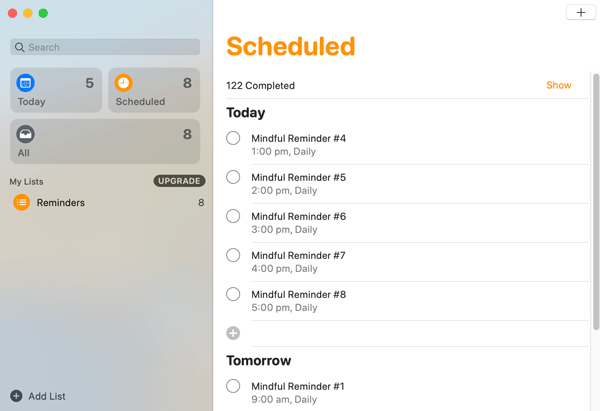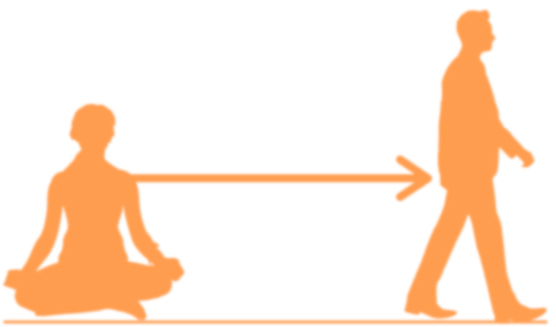Knowing how to practice mindfulness throughout the day changes everything.
It's largely necessary for awakening and serious spiritual growth.
While not being too robotic about things (an emphasis on caring for the heart is vital for the incorporation of mindfulness into daily life),
we can also look at this through a pragmatic lens.
That is, incorporating strategies that reliably result in mindful presence until it becomes our default abiding state.
The new habit pattern of mind.
But first, it is worth mentioning why we are doing this.
In our busy lives, we can become so disconnected and un-grounded from our bodies.
We lose presence.
By engaging a mindful shift, we are ‘re-grounding’ ourselves and inclining the mind toward investigation of our experience that can lead to liberating spiritual insights that reduce suffering.
It can also bridge us from our heads to our hearts.
From this place, we make better decisions and act more skillfully - IE, for the benefit of ourselves and others rather than operating from anger/fear/greed.
In short, our well being is greatly enhanced with regular mindful shifts that impacts not just ourselves, but others around us.
Having meditated for thousands of hours, here are 3 of the most powerful strategies I’ve found for bringing mindfulness to daily life.
I encourage you to pick at least one if you have an interest in bringing mindfulness to your daily life.
Trying to do too much at once won’t do you any good.
HOW TO PRACTICE MINDFULNESS THROUGHOUT THE DAY:
STRATEGY 1: MINDFUL PROMPTS
This strategy is powerful for both beginner and advanced practitioners of mindfulness.
We can get so tied up in tasks that we often forget to check in with ourselves.
This is a problem.
But it can easily be resolved with a prompt that reminds you to be mindful.
Obviously, there are many ways to do this.
Below are some examples that I often use.
- Tagging certain objects such as your car door, shower door, door handles.
- Setting a phone alarm every 60 minutes.
- Using phone apps like ‘Waking up’ that have built in features to remind you to be mindful.
I would recommend keeping it simple with adding some form of mindful prompt every 60–90 minutes on either your computer or phone.
However, don’t shy away from being creative and implementing a prompt where you engage most often.
The sky is the limit here.
Personally, I use a built-in Free application on my Macbook Pro literally called ‘Reminders’.
Every hour, I receive a notification that reminds me to tune into my heart and mind and re-establish a strong tether to presence.
It is worth mentioning this strategy presents a minor trap.
One might become so dependent on mindful reminders that they lose confidence to remain mindful moment to moment.
Do not make this mistake. When receiving a prompt, use it as a burst of attention to carry on being mindful. Utilizing this strategy, we bridge the gap between mindful prompts and develop more continuous mindfulness over time.
STRATEGY 2: FROM MEDITATION CUSHION TO DAILY LIFE:
This should not be underestimated.
Often, we might go about a meditation sit.
The bell rings.
We get up, walk to the kitchen, and then the familiar patterns kick back in.
What will I have for lunch? What do I have to do with the kids? Who do I have to contact?
We lose presence.
Sort of like this nutter.
But when we finish up a meditation sit, this is a perfect opportunity to bring a heightened state of awareness into our daily life.
Try to maintain that mindful awareness as long as you can.
Pay attention to your heightened sensory clarity. The high resolution quality of sensations in the body. Of the cold water running over your hands. Of the sensations of your feet walking across the floor. Of the sounds, smells, tastes your encounter.
This way, over time - you will bridge the gap from meditation cushion to daily life over time.
A no-brainer, but people often neglect this.
Don’t be one of them!
STRATEGY 3: USING A MINDFUL ANCHOR:
The idea behind a mindful anchor is to pick one meditative object that you reliably fall back on to keep you embodied.
This might be:
- The breath,
- The sensations of walking on the feet
- Sounds, smell, tastes..
Anything...
The most common mindful anchor is the breath at the nostrils as it is most accessible.
Pick something that works best for you.
You might ask: what do you do I do with this mindful anchor?
It’s very simple.
Let’s use the breath at the nose as an example.
Every time you remember to, engage mindfully with the sensations of that area of the body fully and completely.
Make a note of these sensations with a gentle mental label.
Feeling, Feeling, Feeling.
Any time something else becomes more predominant, such as a sight, feel free to begin noting that.
Feeling, Feeling, Feeling, Seeing, Seeing, Feeling, Feeling, Feeling, Seeing.
Notice that our mindful anchor remains our predominant object of meditation.
This is simply because having a default object to fall back on will more reliably maintain continuity of mindfulness.
In other words, if your mind is so scattered noting everything, it won’t be stable enough.
**
As I mentioned, I recommend picking at least one of these strategies to apply.
This is important, as the capacity to bring mindfulness to daily life separates the chad meditators from normie meditators.
Using very technical language, of course.
You might want to check out the video I did on this too. It goes into more depth on traps of these strategies and also includes a bonus tip at the end to help you live more mindfully.
How To Practice Mindfulness In Everyday Life (DO THIS TO AWAKEN):
Happy practicing, best wishes!










